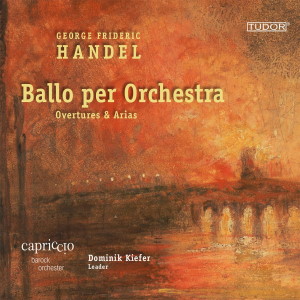
George Frideric Handel (1685-1759)
Ballo per Orchestra
Capriccio Barockorchester/Dominik Kiefer
rec. 2020, Martinskirche, Basel
TUDOR 7197 [62]
Barely a month goes by without another new recording of a Handel oratorio or opera, lavishly cast, incisively performed along historically-informed principles, that is seems almost retrogressive to see Tudor’s new release of overtures, dances and short instrumental interludes. These Ritorrnelli, Sinfonias and Sarabandes form the basis of a kind of concept album, divided into two parts; the first part is dominated by the horns, the second is led by the trumpets.
Part of the fun of the pieces is that the vocal music is refashioned instrumentally. You’ve probably heard, late at night on the radio and unable to sleep, Ombra mai fu played on a cello, or Lascia ch’io pianga on the oboe; that’s the kind of thing we have here in arias from Rinaldo or Belshazzar. Capriccio Barockorchester under their concertmaster/director Dominik Kiefer are deft hands at this repertoire and play with sensitivity and rhythmic verve. They clearly relish the bracing dissonances of Samson where the horns burble with contentment, and the organ and winds – sympathetically chirping – are well balanced in Ariodante’s Sinfonia as is the harpsichord, which is the soloistic focus in the same work’s Vo’ far guerra, where the recorder runs trippingly over accompanying string figuration.
The individual movements are lively, with the folksy recorder and rustic ensemble dominating Almira’s Riternello – Almira is one of Handel’s less documented works – whilst veiled melancholy suffuses the transformed aria that follows. In Occhi belli, from Il Pastor Fido, the harpsichord (Yves Bilger), and then a solo violin, played by Filip Rekiec, take over the vocal line, decorating aptly.
The second part is lively and enjoyable though the track listing fails to credit the bassoonist, Rainer Johannsen, for his contribution. Softest Sounds, from Athalia is gifted to the flute, the accomplished Keiko Kinoshita and to the oboe of Aleksandr Fester.
Tudor’s conceit here is to extract these instrumental elements from Handel’s oratorios and operas and present them as a string of orchestral movements. They note that these movements are ‘hardly ever perceived as a separate category’ and thus the scene-changing, dance, textless celebratory music and suspense-generating movements are given independent life in this disc.
If you’re after an instrumental ‘highlights’ selection from a variety of Handel’s large-scale music this is a well-played example.
Jonathan Woolf
Contents
Samson, HWV57: Overture
Ariodante, HWV33: Sinfonia: Ballo
Rinaldo, HWV7: Augelletti – Adagio: Vo’ far Guerra
Giulio Cesare, HWV17: Sinfonia
Teseo, HWV9: Overture
Belshazzar, HWV61: Let festal joy
Imeneo, HWV41: Menuet: Overture
Almira, HWV1: Ritornello
Alcina, HWV34: Sarabande
Almira: Sprich vor mir ein süßes Wort
Il Pastor Fido, HWV8: Occhio belli
Atalanta, HWV35: Overtures 1 and 2
Judas Maccabeus, HWV63: With honour let desert be crowned
Ariodante, HWV33: Rondeau
Athalia, HWV52: Softest Sounds
Partenope, HWV27: Sinfonia
Help us financially by purchasing through





















